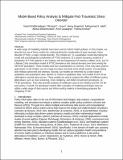Model-Based Policy Analysis to Mitigate Post-Traumatic Stress Disorder
Author(s)
Ghaffarzadegan, Navid; Larson, Ricahrd C.; Fingerhut, Henry; Jalali, Mohammad; Ebrahimvandi, Alireza; Quaadgras, Anne; Kochan, Thomas; ... Show more Show less
DownloadGhaffarzadeganEtal2016PTSD Modeling Book ChapterSubmitted.pdf (821.2Kb)
Metadata
Show full item recordAbstract
A wide range of modeling methods have been used to inform health policies. In this chapter, we describe the use of three models for understanding the complexities of post-traumatic stress disorder (PTSD), a major mental disorder. The models are: 1) a qualitative model describing the social and psychological complexities of PTSD treatment; 2) a system dynamics model of a population of PTSD patients in the military and the Department of Veterans Affairs (VA); and 3) a Monte Carlo simulation model of PTSD prevalence and clinical demand over time among the OEF/OIF population. These models have two characteristics in common. First, they take systems approaches. In all models, we set a large boundary and look at the whole system, incorporating both military personnel and veterans. Second, our models are informed by a wide range of qualitative and quantitative data. Model I is rooted in qualitative data, and models II and III are calibrated to several data sources. These models are used to analyze the effect of different policy alternatives, such as more screening, more resiliency, and better recruitment procedures, on PTSD prevalence. They also provide analysis of healthcare costs in the military and the VA for each policy. Overall, the developed models offer examples of modeling techniques that can utilize a wide range of data sources and inform policy makers in developing programs for mitigating PTSD.